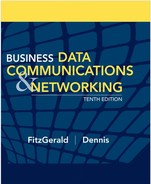PREFACE
Over the past few years, many fundamental changes have occurred in data communications and networking that will shape the future for decades to come. Networking applications such as the Internet and World Wide Web have exploded into the business world. High-speed modems providing megabit data rates (millions of bits per second) over regular telephone lines and cable TV circuits are widely available. New local area network (LAN) and backbone technologies providing gigabit (billions of bits per second) speeds are now available. Wide area network (WAN) technologies providing terabit (trillions of bits per second) to petabit (quadrillions of bits per second) speeds are on the horizon. The integration of voice and data communication is moving rapidly.
Perhaps the most important change has been the recognition of the strategic importance of communications and networking in both the public and private sector. Today, almost all computers are networked. As we look back on the 1990s, we realize that the importance of the computer was surpassed by the importance of the network.
PURPOSE OF THIS BOOK
Our goal is to combine the fundamental concepts of data communications and networking with practical applications. Although technologies and applications change rapidly, the fundamental concepts evolve much more slowly; they provide the foundation from which new technologies and applications can be understood, evaluated, and compared.
This book has two intended audiences. First and foremost, it is a university textbook. Each chapter introduces, describes, and then summarizes fundamental concepts and applications. Management Focus boxes highlight key issues and describe how networks are actually being used today. Technical Focus boxes highlight key technical issues and provide additional detail. Mini case studies at the end of each chapter provide the opportunity to apply these technical and management concepts. Hands on exercises help to reinforce the concepts introduced in the chapter. Moreover, the text is accompanied by a detailed Instructor's Manual that provides additional background information, teaching tips, and sources of material for student exercises, assignments, and exams. Finally, our Web page will continue to update the book.
Second, this book is intended for the professional who works in data communications and networking. The book has many detailed descriptions of the technical aspects of communications, along with illustrations where appropriate. Moreover, managerial, technical, and sales personnel can use this book to gain a better understanding of fundamental concepts and trade-offs not presented in technical books or product summaries.
WHAT'S NEW IN THIS EDITION
The eleventh edition has five major changes from the tenth edition. First, we combined wireless and wired LANs into one chapter and thus reduced the number of chapters from 13 to 12.
Second, we have expanded and added new hands-on activities with deliverables to each chapter. Several labs are included that use Wireshark. The activities are designed to reinforce the key concepts in each chapter, as well as to provide an interesting, practical use of network technology. These activities could be used as demonstrations in class, lab exercises, or activities given as homework. In any event, we believe they will help students better understand key concepts.
Third, Chapter 5 has been significantly updated. More detailed description of the TCP/IP handshakes is provided and a new section in this chapter describes the anatomy of a router. This additional material should make it easier for the students to understand TCP/IP.
Fourth, the chapter on network security now has a new hand-on assignment that asks the students to use PGP and encrypt and decrypt an e-mail message using public key encryption. This assignment will help students to better understand how to post ones public key and what it takes to encrypt a message.
Finally, what is just as important as what has been added is what has been removed. As new technologies arrive it is important to reduce complexity and bulk by removing older technologies that are fading from use.
Online Animations www.wiley.com/college/fitzgerald
For students and instructors, we're offering online animations that help students visualize basic data communications processes. These animations can be used in the classroom or as a study aid for students. To access the animations, go to the Student Resources site.
Lab Exercises www.wiley.com/college/fitzgerald
This edition includes an online lab manual with many hands-on exercises that can be used in a networking lab. These exercises include configuring routers and servers and other additional practical topics. This edition also includes a series of OPNET labs; OPNET is a network simulation tool.
Online Supplements for Instructors www.wiley.com/college/fitzgerald
Instructor's supplements include an Instructor's Manual that includes teaching tips, war stories and answers to end of chapter questions, a Test Bank that includes test questions for each chapter, and Lecture Slides in PowerPoint for classroom presentations. All are available on the Instructor's Resources site.
ACKNOWLEDGMENTS
My thanks to the many people who helped in preparing this edition including my friends at Cisco both current and retired—John Chambers, John Morgridge, and David Alexander. I am indebted to the staff at John Wiley & Sons for their support, including Beth Lang Golub, information systems editor; Rachael Leblond, editor; Janet Foxman, production editor; and Chris Ruel, marketing manager.
I would also like to thank the reviewers for their assistance, often under short deadlines:
Dr. Marie Pullan, Farmingdale State College
Dr. Richard Martin, DeSales University
Bob Gehling, Auburn University—Montgomery Ernest DeFalco, Farmingdale State College
Gary Dwayne Whitten, Texas A&M University
Rahul Basole, Georgia Institute of Technology
Dr. Sunil Hazari, Walden University
Biswadip Ghosh, Metropolitan State College
Sharmini Thurairasa, Swinburne University of Technology
Susan Frank, Farmingdale State College
David Croasdell, University of Nevada, Reno
Moshe Schneider, Empire State College—SUNY
Dr. Gerard Morris, Metro State College of Denver
Scott Arena, Boston University
Quinn Shao, Webster University
Kurt Demaagd, Michigan State University
Harry Reif, James Madison University
Debananada Chakraborty, State University of New York at Buffalo
Masoud Naghedolfeizi, Fort Valley State University
Joseph Bullington, Georgia Southern University
Jackie Woldering, Cleveland State University
Dale Suggs, Campbell University
Christian Matt Graham, University of Maine
Lei Li, Columbus State University
Alan Dennis
Bloomington, Indiana
